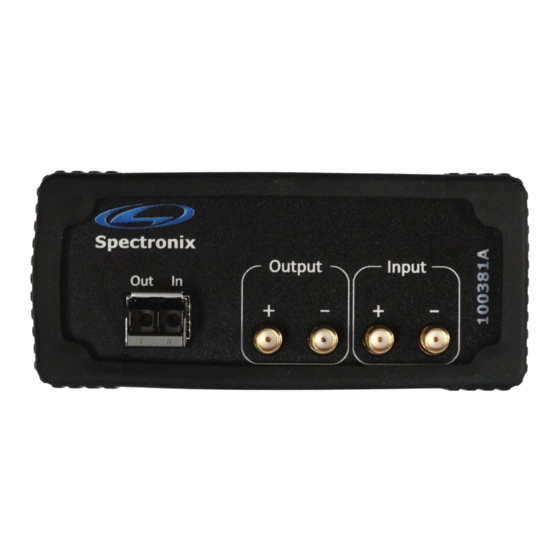
Table of Contents
Advertisement
Quick Links
Overview:
The Eye-BERT Gen2 is a low cost, easy to use, stand-alone bit error rate tester offering high
performance testing from 125Mbps to 4.25Gbps and from 9.9Gbps to 11.4Gbps in a single package.
The Eye-BERT combines the capabilities of the Eye-BERT Micro and the Eye-BERT Micro 10G while
adding electrical SMA interfaces and a color touch screen. The Eye-BERT accepts any MSA
compatible SFP or SFP+ transceiver for optical bit error rate testing. Using the differential SMA inputs
and outputs, electrical or mixed mode optical / electrical testing can be performed.
Warnings and Precautions:
Do not exceed manufacturers recommended electrical or optical input power on any port
Use only compatible fiber optical connectors and modules
Use only the supplied 5VDC power supply
Observe ESD precautions when handling
Proper ventilation may be required depending on the environment and transceiver
SMA connectors can be easily damaged by excessive mechanical strain or force. Strain relief
or other precautions should be used to prevent damage.
Connections
All data connections are located on the front of the unit and power, USB, optional Ethernet (not
shown), and the reference clock are located on the rear of the unit. The table below describes each
of these interfaces in detail.
Connection
SFP+ Slot
Electrical Outputs
www.spectronixinc.com
Description
An MSA compliant SFP or SFP+ transceiver can be inserted into this
slot to produce the selected optical test pattern. The SFP receiver
can be selected as the input source for bit error rate testing. If only
electrical interfaces are required, the SFP is not required.
A pair of 100Ω differential SMA connectors serve as the electrical
data output port. The nominal differential amplitude is 900mVpp.
This interface transmits the selected test pattern unless disabled.
Note if this interface is used, both outputs should be terminated with
50Ω.
Page
Eye-BERT Gen2
1
Users Manual
Eye-BERT Gen2 User's Guide V 1.11
Advertisement
Table of Contents

Summary of Contents for Spectronic Eye-BERT Gen2
- Page 1 Users Manual Overview: The Eye-BERT Gen2 is a low cost, easy to use, stand-alone bit error rate tester offering high performance testing from 125Mbps to 4.25Gbps and from 9.9Gbps to 11.4Gbps in a single package. The Eye-BERT combines the capabilities of the Eye-BERT Micro and the Eye-BERT Micro 10G while adding electrical SMA interfaces and a color touch screen.
- Page 2 Additionally there are two buttons near the bottom of the screen which are used to enter the configuration screens and reset all BERT counters. www.spectronixinc.com Page Eye-BERT Gen2 User’s Guide V 1.11...
- Page 3 Grey: Indicates the output is not active Pressing this button displays the configuration screens as described Conf Button in the following section Reset Button Pressing this button resets all BERT counters www.spectronixinc.com Page Eye-BERT Gen2 User’s Guide V 1.11...
- Page 4 Remote / computer control of the Eye-BERT is possible via the USB or Ethernet ports (if supplied). For more information on using these interfaces consult the “Eye-BERT Gen2 Software Programming Guide”. Note software is not supplied with the Eye-BERT Gen2.
- Page 5 The Eye-BERT Gen2 is normally used to measure patterns originating from its own pattern generator, however, it is possible to configure the unit to measure the BER of a second Eye-BERT Gen2, Eye- BERT Micro, or Eye-BERT Micro 10G with some limitations. When testing at rates above 9Gbps simply configure both units with the same rate and pattern and begin testing.
- Page 6 LETTER OF VOLOTILITY The Eye-BERT Gen2 contains both volatile and non volatile memory. The Eye-BERT firmware application, settings, and network configuration are stored in non volatile memory and program variables and settings are stored in volatile RAM which is cleared upon power down. The user has no means of directly altering the non volatile memory without opening up the unit and reprogramming the device using a special programming adapter.

Need help?
Do you have a question about the Eye-BERT Gen2 and is the answer not in the manual?
Questions and answers